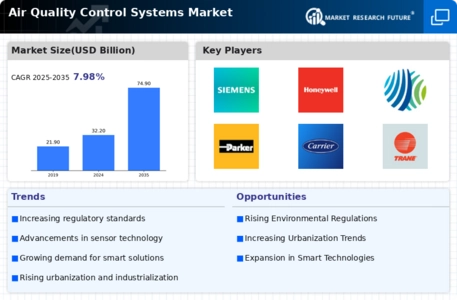Rising Health Awareness
The increasing awareness regarding health issues associated with poor air quality is a primary driver for the Air Quality Control Systems Market. As individuals become more cognizant of the health risks posed by pollutants, there is a growing demand for effective air quality management solutions. Studies indicate that air pollution contributes to various respiratory and cardiovascular diseases, prompting both consumers and businesses to seek advanced air quality control systems. This trend is reflected in market data, which shows a projected growth rate of approximately 8% annually in the air quality control sector. Consequently, manufacturers are innovating to provide systems that not only monitor but also improve air quality, thereby enhancing public health outcomes.
Technological Advancements
Technological advancements play a crucial role in shaping the Air Quality Control Systems Market. Innovations such as the integration of IoT devices and AI algorithms have revolutionized air quality monitoring and management. These technologies enable real-time data collection and analysis, allowing for more precise control of air quality. Market data suggests that the adoption of smart air quality control systems is expected to increase significantly, with a projected market size reaching USD 10 billion by 2027. This growth is driven by the need for efficient and automated solutions that can adapt to varying environmental conditions, thus enhancing the effectiveness of air quality management.
Urbanization and Industrial Growth
The rapid pace of urbanization and industrial growth is a significant driver for the Air Quality Control Systems Market. As cities expand and industries proliferate, the demand for effective air quality management systems intensifies. Urban areas are often characterized by higher levels of pollution, necessitating the implementation of robust air quality control measures. According to recent market analyses, the urban air quality control systems segment is expected to witness a compound annual growth rate of 9% over the next five years. This trend underscores the urgent need for innovative solutions that can mitigate the adverse effects of urban pollution, thereby fostering healthier living environments.
Government Regulations and Policies
Government regulations and policies aimed at improving air quality are pivotal in driving the Air Quality Control Systems Market. Many countries have established stringent air quality standards to combat pollution and protect public health. These regulations often mandate the installation of air quality control systems in various sectors, including manufacturing, transportation, and residential areas. Market data indicates that compliance with these regulations is expected to propel the demand for air quality control systems, with an estimated market growth of 7% annually. As governments continue to prioritize environmental health, the role of air quality control systems becomes increasingly critical in achieving regulatory compliance.
Increased Focus on Indoor Air Quality
The heightened focus on indoor air quality is emerging as a key driver for the Air Quality Control Systems Market. With more individuals spending significant time indoors, the quality of indoor air has garnered attention due to its impact on health and productivity. Research indicates that indoor air can be more polluted than outdoor air, leading to a surge in demand for air quality control systems designed for residential and commercial spaces. Market projections suggest that the indoor air quality segment will grow at a rate of 10% over the next few years. This trend highlights the necessity for advanced filtration and purification technologies to ensure safe and healthy indoor environments.

















Leave a Comment